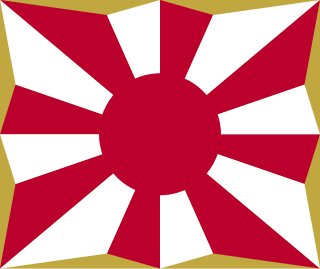
The military history of Japan covers a vast time-period of over three millennia - from the Jōmon to the present day. After a long period of clan warfare until the 12th century, there followed feudal wars that culminated in military governments known as the Shogunate. History of Japan records that a military class and the Shōgun ruled Japan for 676 years - from 1192 until 1868. The Shōgun and the samurai warriors stood near the apex of the Japanese social structure - only the aristocratic nobility nominally outranked them. The sakoku policy effectively closed Japan from foreign influences for 212 years - from 1641 to 1853. Feudal militarism transitioned to imperialism in the 19th century after the arrival of U.S. Admiral Matthew C. Perry in 1853 and the elevation of Emperor Meiji in 1868. Western colonial powers and their imperialist policies impacted on Japan's outlook and led to Japanese colonialism and rampant imperialism until Japan's defeat in World War II. The 1947 Japanese Constitution prohibits Japan from offensively using war against other nations. This led to the establishment of the Japan Self-Defense Forces in 1954. The U.S.–Japan Alliance requires the United States to protect Japan and to conduct offensive duties. In 2015, the Japanese government voted to reinterpret the constitution to allow collective self-defense of Japan's allies.

The Empire of Japan, also known as the Japanese Empire or Imperial Japan, was the Japanese nation-state that existed from the Meiji Restoration on 3 January 1868 until the Constitution of Japan took effect on 3 May 1947. From 1910 to 1945, it included the Japanese archipelago, the Kurils, Karafuto, Korea, and Taiwan. Concessions such as the Kwantung Leased Territory were de jure not parts of the empire but dependent territories. In the closing stages of World War II, with Japan defeated alongside the rest of the Axis powers, the formalized Japanese Instrument of Surrender was issued on 2 September 1945 in compliance with the Potsdam Declaration of the Allies, and the empire's territory subsequently shrunk to cover only the Japanese archipelago resembling modern Japan.
All Nippon Airways Co., Ltd. is a Japanese airline headquartered in Minato, Tokyo. ANA operates services to both domestic and international destinations and is Japan's largest airline, ahead of its main rival flag carrier Japan Airlines. As of April 2023, the airline has approximately 12,800 employees. The airline joined as a Star Alliance member in October 1999.
Keio University, abbreviated as Keio (慶應) or Keidai (慶大), is a private research university located in Minato, Tokyo, Japan. Originally established it as a school for Western studies in 1858 in Edo. It was granted university status in 1920, becoming one of the first private universities in the country.

The Yokosuka D4Y Suisei is a two-seat carrier-based dive bomber developed by the Yokosuka Naval Air Technical Arsenal and operated by the Imperial Japanese Navy from 1942 to 1945 during World War II. Development of the aircraft began in 1938. The first D4Y1 was complete in November 1940 and made its maiden flight at Yokosuka the following month.

The Nakajima Aircraft Company was a prominent Japanese aircraft manufacturer and aviation engine manufacturer throughout World War II. It continues as the car and aircraft manufacturer Subaru.
The Mitsubishi G4M is a twin-engine, land-based medium bomber formerly manufactured by the Mitsubishi Aircraft Company, a part of Mitsubishi Heavy Industries, and operated by the Imperial Japanese Navy from 1940 to 1945. Its official designation is Mitsubishi Navy Type 1 attack bomber and was commonly referred to by Japanese Navy pilots as Hamaki due to the cylindrical shape of its fuselage and its tendency to ignite after a hit. The Allied reporting name was "Betty".

Yokosuka Naval Air Technical Arsenal had many names, each depending on the period of its existence, and the circumstances at that time. Many of the names were acronyms that were derived from its military name or designation, which changed from time to time. The arsenal was sometimes known as "Kūgi-shō". The name Yokosuka prevailed however, even though it referred to the Arsenal's location at Yokosuka, Japan.

The Japan Self-Defense Forces, also known as the Japanese Armed Forces, are the unified military forces of Japan. Established in 1954, the JSDF comprises the Japan Ground Self-Defense Force, the Japan Maritime Self-Defense Force, and the Japan Air Self-Defense Force. They are controlled by the Ministry of Defense with the Prime Minister as commander-in-chief.

The Mitsubishi G3M was a Japanese bomber and transport aircraft used by the Imperial Japanese Navy Air Service (IJNAS) during World War II.

The Rising Sun Flag is a Japanese flag that consists of a red disc and sixteen red rays emanating from the disc. Like the Japanese national flag, the Rising Sun Flag symbolizes the Sun.
The following words are terms used in sumo wrestling in Japan.

The Mechanical Engineering Heritage (Japan) (機械遺産, kikaiisan) is a list of sites, landmarks, machines, and documents that made significant contributions to the development of mechanical engineering in Japan. Items in the list are certified by the Japan Society of Mechanical Engineers (JSME) (日本機械学会, Nihon Kikai Gakkai).

Narita International Airport, also known as Tokyo-Narita International Airport or simply Narita Airport, formerly and originally known as New Tokyo International Airport, is one of two international airports serving the Greater Tokyo Area, the other one being Haneda Airport (HND). It is about 60 km (37 mi) east of central Tokyo in Narita, Chiba. The facility, since July 2019, covers 1,137 hectares of land and construction to expand to nearly 2,300 ha is under way.
The Kirigamine Mita is a training glider, seating two in tandem, designed in Japan in the early 1960s. A modified version, first flown in 1966, was produced in modest numbers.
This page is based on this
Wikipedia article Text is available under the
CC BY-SA 4.0 license; additional terms may apply.
Images, videos and audio are available under their respective licenses.









